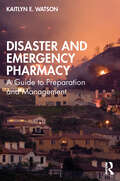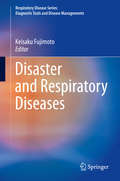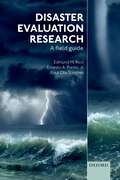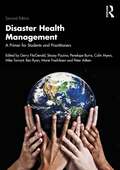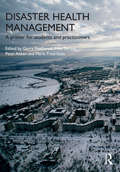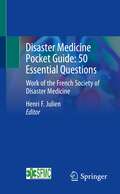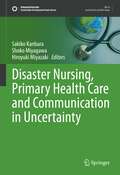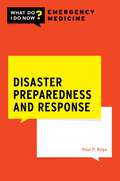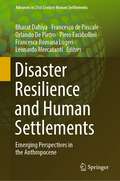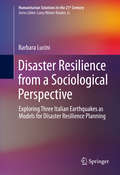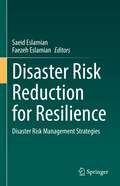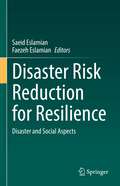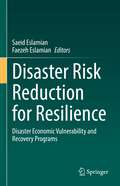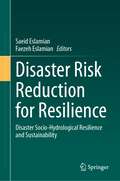- Table View
- List View
Disaster and Emergency Pharmacy: A Guide to Preparation and Management
by Kaitlyn E. WatsonThis important book introduces pharmacists and pharmacy students to the basics of disaster and emergency management, illustrating not only the different roles that pharmacists can play within any disaster or emergency, but the practical steps they can take to prepare for these events. Starting with the UN-recognised Sendai Framework for disaster risk reduction, the book introduces the key concepts and models that pharmacists should understand, before detailing the place of pharmacists within each stage of an emergency or disaster. It also includes interviews with experts in disaster management, shedding light not only on the place of pharmacy within disaster and emergency management, but also the challenges and barriers involved in fulfilling this role. Concluding with practical advice and guidance, as well as how the lessons of disaster and emergency management can inform the everyday role of pharmacists within wider community healthcare, this will be essential reading for both professionals and students in the field.
Disaster and Emergency Pharmacy: A Guide to Preparation and Management
by Kaitlyn E. WatsonThis important book introduces pharmacists and pharmacy students to the basics of disaster and emergency management, illustrating not only the different roles that pharmacists can play within any disaster or emergency, but the practical steps they can take to prepare for these events. Starting with the UN-recognised Sendai Framework for disaster risk reduction, the book introduces the key concepts and models that pharmacists should understand, before detailing the place of pharmacists within each stage of an emergency or disaster. It also includes interviews with experts in disaster management, shedding light not only on the place of pharmacy within disaster and emergency management, but also the challenges and barriers involved in fulfilling this role. Concluding with practical advice and guidance, as well as how the lessons of disaster and emergency management can inform the everyday role of pharmacists within wider community healthcare, this will be essential reading for both professionals and students in the field.
Disaster and Respiratory Diseases (Respiratory Disease Series: Diagnostic Tools And Disease Managements Ser.)
by Keisaku FujimotoThis book provides valuable data on the outbreak, aggravation, treatment and prevention of respiratory diseases based on prior experiences of natural disasters such as earthquakes and tsunamis. Poor hygiene and air pollution can lead to the onset of pneumonia and other respiratory disease, while a lack of medical supplies aggravates existing pulmonary diseases such as chronic obstructive pulmonary disease and asthma. Furthermore, there are cases where those forced to live in cramped conditions, such as cars, following a disaster have developed pulmonary thromboembolism as a result of deep vein thrombosis. The large numbers of patients diagnosed with respiratory diseases make understanding the links between natural disasters and pulmonary disease vital.Disaster and Respiratory Diseases is a valuable resource for all medical staff, including physicians involved in primary care, respiratory medicine and infection control and emergency medicine, as well as respiratory surgeons. It is also useful to national and regional governments concerned about anti-disaster measures.
Disaster Evaluation Research: A field guide
by Edmund M. Ricci Ernesto A. Pretto, Jr. Knut Ole SundnesA human disaster is defined as a hazardous event that overwhelms the capacity of the local community to respond to the needs of the affected population. Medical and public health responses aim to provide care efficiently and promptly but all too often, responses are hampered by recurring mistakes. Analysing the factors at play such as the scale and frequency of disasters and the variety of challenges they present, is central to developing more effective response plans. However the complexity of disasters often precludes reliable data collection, hampering the accuracy of the results, conclusions and recommendations required to improve responses. Disaster Evaluation Research: A field guide presents a new approach to the study of disaster by incorporating a mixed-methods research approach. This practical manual provides a range of reliable methods, robust approaches and proven techniques for the gathering and analyzing of data. Written by leading evaluation scientists with a wealth of experience, the authors present their 'EIGHT Step Model' for disaster evaluation studies. This framework applies evaluation science to disaster responses, helping scientists to select key stakeholders effectively, write evaluation questions, use logic models and mixed-methods research design, prepare sampling plans, collect and analyse data, and prepare a final report. This guide also features useful tools for carrying out evaluations including; evaluation questions, indicators and data sources, resources, and questionnaires used in past evaluation studies. Using a clear, accessible and step-by-step style this practical manual is easy to use in the field and essential reading for medical and public health professionals involved in disaster preparedness and response, humanitarian relief workers, policy analysts, evaluation scientists and epidemiologists.
Disaster Evaluation Research: A field guide
by Edmund M. Ricci Ernesto A. Pretto, Jr. Knut Ole SundnesA human disaster is defined as a hazardous event that overwhelms the capacity of the local community to respond to the needs of the affected population. Medical and public health responses aim to provide care efficiently and promptly but all too often, responses are hampered by recurring mistakes. Analysing the factors at play such as the scale and frequency of disasters and the variety of challenges they present, is central to developing more effective response plans. However the complexity of disasters often precludes reliable data collection, hampering the accuracy of the results, conclusions and recommendations required to improve responses. Disaster Evaluation Research: A field guide presents a new approach to the study of disaster by incorporating a mixed-methods research approach. This practical manual provides a range of reliable methods, robust approaches and proven techniques for the gathering and analyzing of data. Written by leading evaluation scientists with a wealth of experience, the authors present their 'EIGHT Step Model' for disaster evaluation studies. This framework applies evaluation science to disaster responses, helping scientists to select key stakeholders effectively, write evaluation questions, use logic models and mixed-methods research design, prepare sampling plans, collect and analyse data, and prepare a final report. This guide also features useful tools for carrying out evaluations including; evaluation questions, indicators and data sources, resources, and questionnaires used in past evaluation studies. Using a clear, accessible and step-by-step style this practical manual is easy to use in the field and essential reading for medical and public health professionals involved in disaster preparedness and response, humanitarian relief workers, policy analysts, evaluation scientists and epidemiologists.
Disaster Health Management: A Primer for Students and Practitioners
by Gerry FitzGeraldThe second edition of this leading textbook provides the definitive guide to disaster health management. From the key concepts, principles and terminology, to systems for mitigation, planning, response and recovery, it gives readers a comprehensive overview of every aspect of this emerging field. Split into eight parts, the book begins by drawing the parameters of disaster health management before outlining key elements such as communication, community engagement and legal issues. It then moves on to discuss preparing for potential disasters, managing and mitigating their impact, and then recovering in the aftermath. Offering key insights into evaluation, leadership and the psychosocial aspects of disaster health management, the new edition also features a range of international case studies, including those outlining the management of COVID-19.It is essential reading for both students and practitioners engaging in this important work.
Disaster Health Management: A Primer for Students and Practitioners
by Gerry FitzGerald Stacey Pizzino Penelope Burns Colin Myers Mike Tarrant Ben Ryan Marie Fredriksen Peter AitkenThe second edition of this leading textbook provides the definitive guide to disaster health management. From the key concepts, principles and terminology, to systems for mitigation, planning, response and recovery, it gives readers a comprehensive overview of every aspect of this emerging field. Split into eight parts, the book begins by drawing the parameters of disaster health management before outlining key elements such as communication, community engagement and legal issues. It then moves on to discuss preparing for potential disasters, managing and mitigating their impact, and then recovering in the aftermath. Offering key insights into evaluation, leadership and the psychosocial aspects of disaster health management, the new edition also features a range of international case studies, including those outlining the management of COVID-19.It is essential reading for both students and practitioners engaging in this important work.
Disaster Health Management: A Primer for Students and Practitioners
by Gerry FitzGerald Mike Tarrant Peter Aitken Marie FredriksenDisaster health is an emerging field that focuses on developing prevention, preparation, response and recovery systems for dealing with health problems that result from a disaster. As disasters worldwide differ in their nature, scope and cultural context, a thorough understanding of the fundamental tenets of sound disaster health management is essential for both students and practitioners to participate confidently and effectively in the field. Disaster Health Management is the first comprehensive textbook to provide a standard guide to terminology and management systems across the entire spectrum of disaster health. Authored by experienced educators, researchers and practitioners in disaster health management, this textbook provides an authoritative overview of: The conceptual basis for disaster management Systems and structures for disaster management Managing disasters through the continuum of preparedness, response and recovery The variations associated with both natural and technological disasters The strategic considerations associated with leadership, research, education and future directions. Using Australasian systems and structures as examples of generic principles which will find application globally, Disaster Health Management is an essential text for both undergraduate and postgraduate students, as well as for professionals involved in all aspects of disaster management.
Disaster Health Management: A Primer for Students and Practitioners
by Gerry FitzGerald Mike Tarrant Marie Fredriksen Peter AitkenDisaster health is an emerging field that focuses on developing prevention, preparation, response and recovery systems for dealing with health problems that result from a disaster. As disasters worldwide differ in their nature, scope and cultural context, a thorough understanding of the fundamental tenets of sound disaster health management is essential for both students and practitioners to participate confidently and effectively in the field. Disaster Health Management is the first comprehensive textbook to provide a standard guide to terminology and management systems across the entire spectrum of disaster health. Authored by experienced educators, researchers and practitioners in disaster health management, this textbook provides an authoritative overview of: The conceptual basis for disaster management Systems and structures for disaster management Managing disasters through the continuum of preparedness, response and recovery The variations associated with both natural and technological disasters The strategic considerations associated with leadership, research, education and future directions. Using Australasian systems and structures as examples of generic principles which will find application globally, Disaster Health Management is an essential text for both undergraduate and postgraduate students, as well as for professionals involved in all aspects of disaster management.
Disaster Management: Medical Preparedness, Response and Homeland Security
by Mark Huntington Dale Vincent Marcia Trainer Monideepa Roy Gerald Kost Steven Parrillo Anders Ruter Rostislav Kostadinov Jameel Ali Yoram Weiss Aaron Richman Fernando Turégano Levent Kenar Professor Robert Chilcott Edward Waller P Thullier Christophor Dishovsky J Bajgar Christopher Cocking Suresh Bada Math David Allen Itamar Ashkenazi Jean B Bail Miklosh Bala Nibedita Ray-Bennett Giles Barrier Benjamin W Berg J R Bhardwaj Raman Chawla Anish V Cherian Maria Nirmala Christine Timothy P Cohen Corbin Curtis Tahir Ahmed Dar Shabir Dhar Christopher R Foerster Anju Goel Rajiv Goel Rupa Gunaseelan James Hagen Scott P Hagen Mahmood Hosseini Yasamin Izadkhah Michael Hust Denis Josse Vinod Kaushik Kamen Kanev Naveen C Kumar Richard Louie Nandini Mukherjee Sudeep Nayak Mesut Ortatatli Douglas Paton Thibaut Pelat Kai-Lit Phua Ann Sakaguchi Rakesh Sharma Stoian Tonev Yuval WeissDisaster management is an increasingly important subject, as effective management of both natural and manmade disasters is essential to save lives and minimize casualties. This book discusses the best practice for vital elements of disaster medicine in both developed and developing countries, including planning and preparedness of hospitals, emergency medical services, communication and IT tools for medical disaster response and psychosocial issues. It also covers the use of state-of the-art training tools, with a full section on post-disaster relief, rehabilitation and recovery.
Disaster Medicine: A Case Based Approach
by David MacGarty and David NottWhether switching on the TV, picking up a newspaper or simply logging on to the internet, one is constantly faced with images of natural disasters, conflict and human suffering. Humanity has experienced these problems throughout time and we have evolved methods and mechanisms for alleviating suffering, from trauma care following a traffic accident to international pacts and the Millennium Development Goals. In exploring such diverse cases of aid intervention, Disaster Medicine: A Case Based Approach provides interesting, easily accessible content and context for understanding disaster medicine and global health. In each case the reader will be put in the position of the decision maker and as in real life some of the cases will portray success and some will show failure. It is hoped the reader will consider the issues and problems for themselves and perhaps consider things they would choose to do differently. Written by a team of experts with extensive experience in the field and a progressive perspective Disaster Medicine: A Case Based Approach is a valuable text for students and professionals of disaster medicine.
Disaster Medicine Pocket Guide: Work of the French Society of Disaster Medicine
by Henri F. JulienA very handy practical book written by French doctors specialised in disaster medicine, this guide offers their core experience condensed in 50 small, easily digestible chapters. Each chapter is designed to enable the reader to “know”, “understand”, and learn what to “do” in the concerned situation, ensuring the crucial information is easily on hand and available.Facing disasters, whether natural or man-made, technological or social, what are the risks and the consequences of such hazards on victims? What kind of care to provide? How to get organised, to have the appropriate resources, and to protect oneself as a responder? The French emergency and healthcare preparedness has followed a unique path. The responding medical doctors have followed in the footsteps of Dominique Larrey, a military surgeon and the father of emergency medicine. For him, the on-scene presence of doctors is paramount to organise the entire healthcare and emergency response, an innovative method that has proven its efficacy. This book is intended for all healthcare and emergency staff, doctors, paramedics or first aiders in ambulances or in emergency services who might come to deal with a massive influx of injured, poisoned, or traumatised victims. The management of multiple concomitant emergencies requires specific know-how and skills. May this guide contribute to the dissemination of a validated French know-how and thus to save lives and alleviate suffering.
Disaster Nursing, Primary Health Care and Communication in Uncertainty (Sustainable Development Goals Series)
by Sakiko Kanbara Shoko Miyagawa Hiroyuki MiyazakiThe primary aim of this textbook is to contribute towards the promotion of human security by educating nurses with a profound understanding of disaster nursing and to conduct innovative research and practices in cooperation. This textbook emphasizes on multi-professional connections; offers knowledge on how Japanese disaster nursing got evolved in changing social contexts and provides various case studies that reflect wonderful practices in the disaster nursing field which have contributed to the Sendai Framework for Disaster Risk Reduction, the UN Sustainable Development Goals, and sustainable human security. Frequent disasters have triggered the need for more trans-disciplinary work, high-level care throughout all phases of a disaster event, and the need for nursing leaders. Apart from hospitals, in local communities, nurses can take a role to mitigate health risks. Being a member of every part of the healthcare system, they can become critically needed leaders in emergency management and disaster preparedness. This work includes a DRR Framework and the application to disaster nursing, information on preparedness and community resilience and on the related disciplines and coordination with disaster nursing. It informs on the challenges in disaster nursing, offers instructional design, education development and research in disaster nursing. Students, professional nurses, clinicians, community health practitioners, health volunteers, disaster support organizations, researchers, and community partners who are involved in the care of disaster survivors can use this resource. Written by distinguished experts with diverse backgrounds of nursing, public health, health informatics, and geography, this book shows how practitioners, researchers, policymakers, and multiple community stakeholders who can collaborate effectively and efficiently to restore primary health care of survivors after a local disaster.
Disaster Preparedness and Response (WHAT DO I DO NOW EMERGENCY MEDICINE)
by Paul P. RegaDisaster medicine has occupied an increasingly important niche within the specialty of emergency medicine over the latter half of the 20th century. Regardless of whether an event was natural, anthropogenic, or a combination of both, emergency medicine was and is the ideal discipline to develop the human resources, the strategies, the tactics, and the evidence- based research to elevate the field of disaster medicine. It began, organizationally speaking, with Hurricane Hugo in 1989 and it is continuing through the 2019 COVID- 19 pandemic and beyond. Now that we are well into the 21st century, we must steady our footing as a specialty on the 20th century's foundation so that we can wrestle with the more intricate challenges of the future. In the past two decades our global populations have experienced sectarian violence, wars, genocide, migration, terrorism, emerging infectious diseases, and pandemics. These natural and anthropogenic events will only worsen exponentially as we become intrinsically trapped by the effects of climate change. The United Nation's Intergovernmental Panel on Climate Change has recently concluded that regardless of how we try to reverse the effects of global warming, what we are experiencing now in terms of hurricanes, floods, and droughts will continue to worsen over the next 30 years. Should we, as a species, continue to equivocate and as global temperatures climb, these events will become more frequent and more catastrophic. "Catastrophic" may even be too mild a term. It is possible that over the next few years, the academic arm of emergency medicine may need to consider developing a curriculum devoted to "Cataclysmic Medicine." To confront these possibilities, there first needs to be a knowledge of disaster medicine and disaster management at its most basic level. It begins with crisis leadership, command and control, communications, and coordination. When all these pieces of the jigsaw puzzle are fitted together properly and enclosed by a proper ethical frame, then the best and most ethical and moral disaster medical can will be provided to the patient and to the community. The intent of this book is to introduce these concepts using diverse viewpoints and scenarios. Readers are challenged to cogitate, create, and layer their own set of building blocks upon the preexisting foundation, thereby reinforcing and sustaining their own capacity to prepare for and respond to any adverse eventuality, mass casualty or otherwise. I hope that the experiential and evidence- based contents of this book will inspire readers to delve deeper into the nuances of disaster medicine and will serve as an impetus for a more profound quest for knowledge and a desire to serve those who will be experiencing the worst moments of their lives. The intent of this book is to introduce these concepts using diverse viewpoints and scenarios. Readers are challenged to cogitate, create, and layer their own set of building blocks upon the preexisting foundation, thereby reinforcing and sustaining their own capacity to prepare for and respond to any adverse eventuality, mass casualty or otherwise. It is hoped that the experiential and evidence- based contents of this book will inspire readers to delve deeper into the nuances of disaster medicine and it will serve as an impetus for a more profound quest for knowledge and a desire to serve those who will be experiencing the worst moments of their lives.
Disaster Preparedness and Response (WHAT DO I DO NOW EMERGENCY MEDICINE)
by Paul P. RegaDisaster medicine has occupied an increasingly important niche within the specialty of emergency medicine over the latter half of the 20th century. Regardless of whether an event was natural, anthropogenic, or a combination of both, emergency medicine was and is the ideal discipline to develop the human resources, the strategies, the tactics, and the evidence- based research to elevate the field of disaster medicine. It began, organizationally speaking, with Hurricane Hugo in 1989 and it is continuing through the 2019 COVID- 19 pandemic and beyond. Now that we are well into the 21st century, we must steady our footing as a specialty on the 20th century's foundation so that we can wrestle with the more intricate challenges of the future. In the past two decades our global populations have experienced sectarian violence, wars, genocide, migration, terrorism, emerging infectious diseases, and pandemics. These natural and anthropogenic events will only worsen exponentially as we become intrinsically trapped by the effects of climate change. The United Nation's Intergovernmental Panel on Climate Change has recently concluded that regardless of how we try to reverse the effects of global warming, what we are experiencing now in terms of hurricanes, floods, and droughts will continue to worsen over the next 30 years. Should we, as a species, continue to equivocate and as global temperatures climb, these events will become more frequent and more catastrophic. "Catastrophic" may even be too mild a term. It is possible that over the next few years, the academic arm of emergency medicine may need to consider developing a curriculum devoted to "Cataclysmic Medicine." To confront these possibilities, there first needs to be a knowledge of disaster medicine and disaster management at its most basic level. It begins with crisis leadership, command and control, communications, and coordination. When all these pieces of the jigsaw puzzle are fitted together properly and enclosed by a proper ethical frame, then the best and most ethical and moral disaster medical can will be provided to the patient and to the community. The intent of this book is to introduce these concepts using diverse viewpoints and scenarios. Readers are challenged to cogitate, create, and layer their own set of building blocks upon the preexisting foundation, thereby reinforcing and sustaining their own capacity to prepare for and respond to any adverse eventuality, mass casualty or otherwise. I hope that the experiential and evidence- based contents of this book will inspire readers to delve deeper into the nuances of disaster medicine and will serve as an impetus for a more profound quest for knowledge and a desire to serve those who will be experiencing the worst moments of their lives. The intent of this book is to introduce these concepts using diverse viewpoints and scenarios. Readers are challenged to cogitate, create, and layer their own set of building blocks upon the preexisting foundation, thereby reinforcing and sustaining their own capacity to prepare for and respond to any adverse eventuality, mass casualty or otherwise. It is hoped that the experiential and evidence- based contents of this book will inspire readers to delve deeper into the nuances of disaster medicine and it will serve as an impetus for a more profound quest for knowledge and a desire to serve those who will be experiencing the worst moments of their lives.
Disaster Preparedness for Seniors: A Comprehensive Guide for Healthcare Professionals
by Charles A. CefaluDisaster Preparedness for Seniors: A Comprehensive Guide for Healthcare Professionals outlines specific disaster scenarios for homebound, community, hospitalized, long term care, homeless and aged veterans. Chapters are written by a diverse group of authors, all of whom offer insight and expertise in training healthcare professionals in preparing for disasters. Topics include myths and realities of natural disasters and disaster preparedness for special populations of elders-the acute care elderly, the community-dwelling elderly, home based primary care senior veterans, the immune-compromised elderly, those with multiple and co morbid illnesses, the long-term care elderly, those elderly at the end of life and the effects of disaster on caregivers. A significant portion of the book is also devoted to training, competencies, literacy, cultural competency and resilience in disaster preparedness as well as the role of the academic medical center. The volume concludes with coverage of the management of behavioral, medical and psychological consequences of disasters. Disaster Preparedness for Seniors: A Comprehensive Guide for Healthcare Professionals is an important new volume and will serve as a guide for the development of programs, policies and procedures for evacuation of seniors during various disaster scenarios.
Disaster Resilience and Human Settlements: Emerging Perspectives in the Anthropocene (Advances in 21st Century Human Settlements)
by Bharat Dahiya Francesco De Pascale Orlando De Pietro Piero Farabollini Francesca Romana Lugeri Leonardo MercatantiThis book presents emerging perspectives on disaster resilience and human settlements in the larger context of the Anthropocene. The chapters explore urban and rural perspectives focusing on the current and emerging perspectives on disaster resilience through a holistic approach, involving scientists, humanists, planners, policymakers, and professionals in the global debate.
Disaster Resilience from a Sociological Perspective: Exploring Three Italian Earthquakes as Models for Disaster Resilience Planning (Humanitarian Solutions in the 21st Century)
by Barbara LuciniNatural disasters traumatize individuals, disrupt families, and destabilize communities.Surviving these harrowing events calls for courage, tenacity, and resilience. Professional planning requires specific types of knowledge of how people meet and cope with extreme challenges.Disaster Resilience from a Sociological Perspective examines three major earthquakes occurring in Italy over a fourteen - year period for a well-documented analysis of populations' responses to and recovery from disaster, the social variables involved, and the participation of public agencies. This timely volume reviews sociological definitions and models of disaster, identifying core features of vulnerability and multiple levels of individual and social resilience. The analysis contrasts the structural and supportive roles of Italy's civil protection and civil defense services in emergency planning and management as examples of what the author terms professional resilience. And testimony from earthquake survivors and volunteers gives voice to the social processes characteristic of disaster. Among the areas covered:Social context for concepts of disaster, vulnerability, risk, and resilienceTypes of resilience: a multidimensional analysis, focused on a physical, ecological, and ecosystem perspectiveFindings from three earthquakes: loss, hope, and community.Two systems of organizational response to emergenciesToward a relational approach to disaster resilience planning Plus helpful tables, methodological notes, and appendicesFor researchers in disaster preparedness, psychology, and sociology, Disaster Resilience from a Sociological Perspective raises--and addresses--salient questions about people and communities in crisis, and how studying them can improve preparedness in an uncertain future.
Disaster Response Practices: Guide to Mass Casualty/Mass Fatality Management Planning (Management for Professionals)
by Michael MadiganThis book provides guidelines for emergency managers, responders, and health care professionals to establish a mass casualty/mass fatality (MC/MF) management plan. It identifies a need for a stronger and more global management structure for MC/MF events that includes standardized practices of identification, disposition, and possible repatriation to restore the situation to pre-event levels. This book covers this comprehensive process including disaster mortuary operational response teams (DMORTs), simple triage and rapid treatment (START) and national nurse response teams. It also demonstrates leadership in MC/MF events within government agencies, the public sector and international organizations featuring case studies, scenario questions and summaries of lessons learned.
Disaster Risk Reduction for Resilience: Disaster Risk Management Strategies
by Saeid Eslamian Faezeh EslamianThis book is part of a six-volume series on Disaster Risk Reduction and Resilience. The series aims to fill in gaps in theory and practice in the Sendai Framework, and provides additional resources, methodologies and communication strategies to enhance the plan for action and targets proposed by the Sendai Framework. The series will appeal to a broad range of researchers, academics, students, policy makers and practitioners in engineering, environmental science and geography, geoscience, emergency management, finance, community adaptation, atmospheric science and information technology. This volume offers the international guidelines and global standards for resilient disaster risk reduction and lessons learned from disasters, particularly the COVID-19 and Cholera pandemics. A resilient health system and an effective disaster risk management Index are then suggested. The book further emphasizes urban resilience strategies with local authorities, adaptation strategies for urban heat at regional, city and local scales, and lessons from community-level interventions. Also addressed are coastal erosion, displacement and resettlement strategies. Land use planning and green infrastructure are suggested as tools for natural hazards reduction. Human security in times of climate change and urban heat at regional, city and local scales is discussed for an integrated action, with case studies based in Manila, Burkina Faso, Chad, Mauritania, Niger, Senegal, Nigeria, India, Spain, and Ghana. Structure design for cascading disasters resulting from mining and flooding is presented and sustainable smart city planning using spatial data is recommended.
Disaster Risk Reduction for Resilience: Disaster and Social Aspects
by Saeid Eslamian Faezeh EslamianThis book is part of a six-volume series on Disaster Risk Reduction and Resilience. The series aims to fill in gaps in theory and practice in the Sendai Framework and provides additional resources, methodologies, and communication strategies to enhance the plan for action and targets proposed by the Sendai Framework. The series will appeal to a broad range of researchers, academics, students, policy makers, and practitioners in engineering, environmental science, geography, geoscience, emergency management, finance, community adaptation, atmospheric science and information technology.This volume provides a holistic approach to developing disaster risk reduction strategies and policies, exploring the most effective ways to integrate physical and social science aspects of hazard resilience to better inform local populations. This risk-based approach to community resilience development is used to craft a collaborative system for crisis management, and allows for the implementation of nationally determined contributions (NDCs) through social innovation and community engagement to enhance community emergency response support and preparedness. Readers will also learn about education of disaster risk reduction, human health risk assessment, gendered perspectives in disaster response, recovery, and disaster management legislation.
Disaster Risk Reduction for Resilience: Disaster Economic Vulnerability and Recovery Programs
by Saeid Eslamian Faezeh EslamianThis book is part of a six-volume series on Disaster Risk Reduction and Resilience. The series aims to fill in gaps in theory and practice in the Sendai Framework, providing additional resources, methodologies, and communication strategies to enhance the plan for action and targets proposed by the Sendai Framework. The series will appeal to a broad range of researchers, academics, students, policy makers, and practitioners in engineering, environmental science and geography, geoscience, emergency management, finance, community adaptation, atmospheric science, and information technology.This volume focuses on the concepts of economic and development vulnerability, discussing the roles of physical, social, cultural, political, economic, technological, and development factors that contribute to disaster impacts and threat levels on vulnerable populations. This approach explores how the resilience of individuals and communities can be increased in the face of future hazard threats, and how post-disaster efforts are planned for and implemented to manage risk reduction and the potential outcomes of hazard threats. Topics addressed in the boom include disaster recovery reform and resilience, recovery, and development programs, place-based reconstruction policies, resilient and sustainable disaster relief, and recovery programs, sustainable community development, and disaster recovery and post-hazard recovery strategies.
Disaster Risk Reduction for Resilience: Disaster Socio-Hydrological Resilience and Sustainability
by Saeid Eslamian Faezeh EslamianThis book is part of a six-volume series on Disaster Risk Reduction and Resilience. The series aims to fill in gaps in theory and practice in the Sendai Framework, and provides additional resources, methodologies and communication strategies to enhance the plan for action and targets proposed by the Sendai Framework. The series will appeal to a broad range of researchers, academics, students, policy makers and practitioners in engineering, environmental science and geography, geoscience, emergency management, finance, community adaptation, atmospheric science and information technology.This volume discusses the implementation of socio-hydrological resilience measures to curb the impacts on vulnerable communities of hydrologic diasters such as coastal floods, drought, water scarcity, and thunderstorms. The book provides a framework for sustainable hydrology-community interactions to inform local communities about the best practices to achieve hydrological resilience, and to implement resilient water infrastructure. Hydrological influences on the resilience of a region are comprehensively surveyed, and a "green economy strategy" is described and recommended for achieving climatic and hydrological sustainability.
Disaster Risk Reduction in Mexico: Methodologies, Case Studies, and Prospective Views
by Diana Sánchez-Partida José-Luis Martínez-Flores Santiago-Omar Caballero-Morales Patricia Cano-OlivosThis book recognizes Mexico's effects and challenges in a natural disaster and offers empirical risk-reduction methods in critical cases. The proposals considered here include real and detailed analysis, a set of models, frameworks, strategies, and findings in the three stages of the disaster (before–during–after).This book:describes the methodology to find secure locations for the Regional Humanitarian Response Depot;offers recommendations for the sites and creation of an Export Logistics Cluster;shows how to use available technology and information to locate volunteers in the right spotsdescribes mathematical models to help to allocate procedure of resources for restoring the affected communityand proposes actions to create resilience in the country's main economic sectors, including agriculture and industry.The processes applied at recent disasters such as the 19S earthquake and their results are used as case studies, identifying possibilities for further improvement. The book also describes new trends for Mexico due to climate change and makes suggestions for mitigating future disasters. The proposals are also replicable to other highly populated societies with similar socio-economic structures. Finally, this book is the basis for generating more innovative recommendations by researchers, graduate students, academics, professionals, and practitioners to obtain better planning and better collaboration between all the humanitarian chain actors. This book intends to be of interest as a fundamental tool for decision-makers, governments, non-governmental organizations, and enterprises.
Disaster Rules
by Rob Russell Timothy J. Hodgetts Peter F. Mahoney Nicholas CastleThe 80 rules you need to prepare for action in a medical disaster Here are 80 disaster management rules to reflect on, remember and follow in the immediate aftermath of an incident involving mass casualties. Each rule is a single-page long, providing the essential information to inform the most common critical decisions you will have to make in either a civilian or military environment. Written by clinicians with deep clinical and operational experience, these rules are concise evidence-based guidelines for all medical personnel dealing with disasters at the scene or in hospital. Based on the Major Incident Medical Management and Support system widely adopted in the UK, mainland Europe, Australasia and NATO, they are both authoritative and effective.
